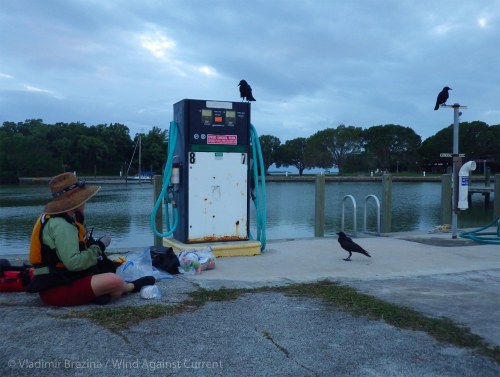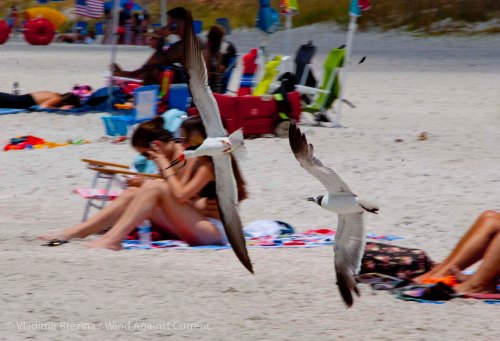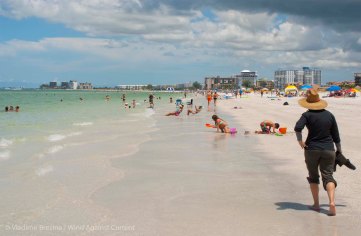By Johna Till Johnson; music and video by Jennifer W. Call
It was Jennifer’s first open water crossing.
We were heading across Tampa Bay on a sunny spring Sunday. Our nominal destination was Cockroach Bay to the southwest, around eight nautical miles away. But really, the goal was to paddle in some open water, spend time together, and see how we functioned as a team.
I glanced to the left.
Jenn was slightly farther away than I’d like, but otherwise she seemed fine, cresting a wave with confidence. We’d been in open water for about half an hour, and conditions had picked up a bit. The current was coming from the southwest with the flood, as anticipated, but it didn’t seem to be too strong. The wind, predicted from the same direction, was inexplicably coming from the east. (Florida rules: Expect the unexpected!)
But I was happy about that, because it generated some nice bouncy wind-against-current waves for Jenn to try her skill on.
The prediction had been for “light chop”, but the waves were a bit more than that. Maybe two feet, with the occasional swell to three. Before we’d left I’d reminded Jenn to brace into the waves if she felt unsteady. The reminder seemed almost unnecessary. Although a relatively novice paddler, Jenn seemed to know exactly what she was doing, and she’d completed the Sweetwater symposium training in February with flying colors.
That’s where we met, in fact. Some of the Sweetwater folks had suggested to her that she meet me: “You two think a lot alike,” they’d told her.
We did. From the moment our two Subarus parked next to each other and she leapt out with an infectious smile, I knew we’d be friends. Another single woman, with a Subaru and a Valley boat on top, and a passion for endurance athletics? Yes!
So it made perfect sense for me to fly down to Tampa, where Jennifer lived, two months later for a kayak-camping trip. The grand plan was to complete the Everglades Challenge in 2019 together. But before we did that, we’d have to see if we could get along, and paddle together.
So far things were looking good. Jennifer had accepted my ever-changing work schedule with good grace, even when it cut into our plans. And the night before, we’d had an absolute blast.
Jenn had suggested we camp on the grounds of MacDill Airforce Base, where she worked. She was currently in a civilian role, but was a retired Naval officer, like my father. So we had that in common.
The night before, we’d arrived just before sunset (in time for the mosquitos to come out in full force). We set up our tents (or rather, her tent and my bivvy sack) and broke out dinner: Military “ready to eat” meals (MREs). Jennifer had been curious about them: “In the Navy we didn’t have MREs, we had C-Rations,” she explained.
The difference? MREs come with a self-heating pack: Just add water, and a chemical reaction causes the pack to heat up and warm the food inside. (Clearly a very bad idea in a ship to have devices that explosively heat up upon contact with water, as Jenn pointed out).
So with eager curiosity, we extracted the all the little packets, and took a close look at the very detailed instructions.
What was this? Step #5 was just a diagram of the MRE packet propped up against… “A rock or something.”
Honest-to-god, that’s what it said! I couldn’t stop laughing.
The MREs turned out to be delicious, and we soon trundled off to bed (another point of commonality: We both like to go to bed early, and wake up early).
The next morning, we drove the short distance to the boat ramp and began loading up. A young couple drove up with a trailer and a fishing boat; we exchanged pleasantries.
When they asked, I mentioned we’d be crossing Tampa Bay in our kayaks. They gaped, and asked: “You can do that?”
I pointed out that the original kayakers went out in far bigger seas, in freezing weather. Still, it made me feel a tad more adventurous.
We launched, and I made another pleasant discovery: Jenn’s knowledge of marine navigation was rock-solid, as befitting a former Naval officer. We were using her boats (she had two Valley Etains) and they both had compasses, which she’d installed herself. We’d picked 180 degrees as our point of navigation, to account for the current, which would tend to push us east.
We paused to let a giant cago ship pass, then set into the channel. And here we were out in the middle of the channel, with choppy, occasionally cresting waves.
I glanced over at her again. She looked fine, but just in case.. I mentally calculated how long it would take me to get to her if she capsized. Longer than optimal, but I’d be paddling with the current, and in warm water, the danger of hypothermia is remote.
We paddled through the chop, and kept going. Ahead of us, the shoreline began to grow larger. We’d made it across the bay!
The chop slowly eased, and I drew closer to Jenn. “How’d it go?” I asked, expecting her to be exuberant. She certainly hadn’t seemed to have had a care in the world.
Instead, she smiled warily. “I was a bit… concerned!”
Concerned? This was a woman who’d guest-piloted an F-18 at near-supersonic speeds? Who had first picked up a paddle a few months ago, and was now cresting waves with confidence?
Then I thought back to my first open-water crossing, across New York harbor. By then I had already been paddling for a couple of years. But still when the swell picked up, I, too, was a bit… concerned.
Jenn had acquitted herself spectacularly well.
The rest of the day ran like an advertisement for Florida paddling. The wind quieted down, and the water shimmered like molten metal. It was cool enough to be comfortable, but the sun behind the peek-a-boo clouds scattered light everywhere. We stopped on an inviting beach for lunch and a photo shoot.
After lunch, we explored the mangroves behind our beach, then turned our bows for home.
The crossing back was as calm as the crossing over had been choppy; the only excitement was when we had to decide whether to cross in front of the cargo ship that appeared suddenly in the distance. We decided to wait—good thing, as it turned out.
We reached our campsite later that afternoon, tired but happy. Jenn had her first paddling blisters—first of many, I warned her—and they made an interesting contrast to the calluses she had from rock climbing.
We took a walk to shake out the stiffness, and treated ourselves to ice cream at the camp store. Then we rigged up a three-way clothesline in a cluster of trees—a “triline”, as Jenn pointed out. (I was delighted by the quirkiness and practicality).
There was just one catch. Even though we’d carefully rinsed out our clothing in the showers, it looked like it was due for a second rinse: Clouds loomed ominously, and off in the distance, thunder growled.
We puttered around the campsite getting ready to prepare dinner. And sure enough, as we were ready to start, the skies opened in a torrential downpour.
What to do?
Jenn’s apartment was just five minutes away. But we were here to camp!
We decided to stick it out, but cook under the eaves of the shower/laundry room, where there were benches.
So we chatted and ate our MREs, listening to the rain drumming on the roof overhead and trying not to think about what it would be like in our tents under the thundering waterfall. Would we be in for a wet, uncomfortable night?
The rain refused to let up, so we walked back to tents in the downpour.
As luck would have it, at the exact moment we said goodnight to each other and unzipped our shelters… the rain stopped.
Snug inside the bivvy sack, I enjoyed the luxury of looking up at the slowly-clearing sky, the fresh night air cool against my face.
The next morning we were up before dawn.
“Look!” Jenn whispered suddenly, pointing.
There, in a space perfectly framed by palmettos and trees, was an osprey nest against the rising sun, was an osprey nest, with both parents inside.
We took photos and smiled at each other. It was a hopeful omen.
And it had been a wonderful couple of days.
Jenn likes to make videos of her adventures! So this short clip will give you a sense of the trip. (Special bonus: Yours truly dissolving in giggles over the “rock or something”). Turn the sound up so you can hear Jenn’s original musical composition.
















































